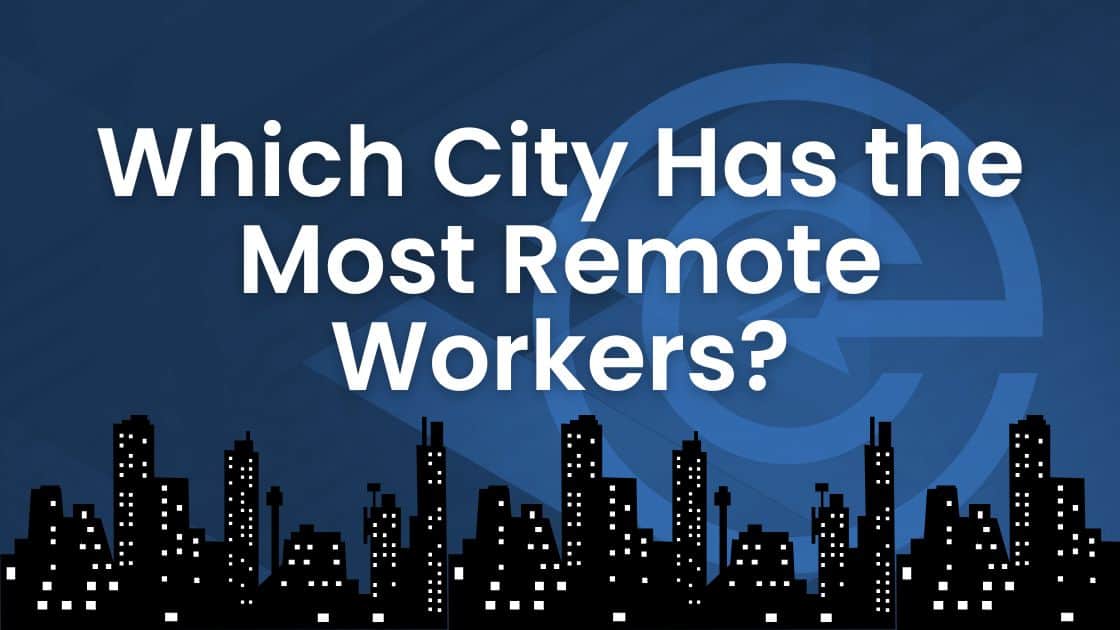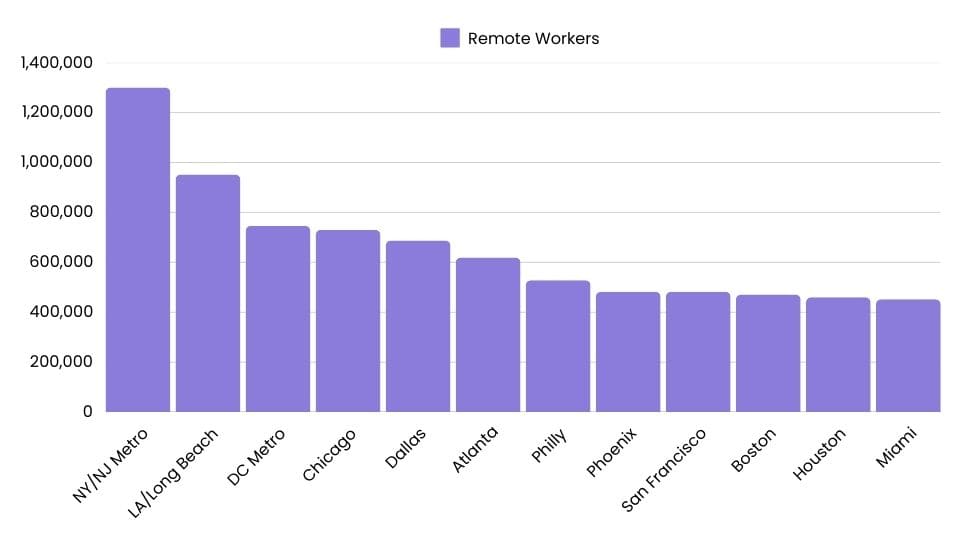
Identifying the City with the Most Remote Employees
Recently, we discovered a remarkable article from Visual Capitalist. It provides a visual breakdown of remote workers across U.S. cities, shedding light on where most remote jobs are concentrated. From California to New York, various metro areas contain a significant amount of remote workers, in spite of the recent RTO trend.
Therefore, we thought it would be helpful to share this data to assist anyone interested in recruiting top talent. Working from home trends like this helps businesses know what workers want in specific locales and assist them in making important hiring decisions, like allowing hybrid or remote options to avoid talent attrition. Since helping businesses make important hiring decisions is at the core of what we do at Corporate Navigators, we decided it was highly relevant to share.

Which City Has The Most Remote Workers?
According to the data provided, the New York/ New Jersey Metro area has the highest number of remote workers with 1.3 million. Number two on the list is the Los Angeles-Long Beach-Anaheim, CA Metro Area with 952,276 individuals engaged in remote work. Third on the list are located around the nation’s capital, the Washington-Arlington-Alexandria, DC-VA-MD-WV Metro Area with 745,855, which comprises one-fifth of the total workers in that area.

Source: Visual Capitalist
The Visual Capitalist Study at a Glance
Overall, this study by Visual Capitalist highlights how remote work has grown significantly in certain metropolitan areas, with cities like San Francisco, New York, and Washington D.C. seeing substantial numbers of remote workers in their ranks.
The data also illustrates how employees in these areas are more likely to have flexible work arrangements. Notably, the geographic distribution of remote work shows a tendency for remote workers to cluster in cities with higher costs of living, but there is also a subtle rise of remote work in lower-cost areas.
| City/Metro Area | # of Remote Workers | Percentage of Workforce |
| New York/ New Jersey Metro | 1,300,973 | 12.50% |
| Los Angeles-Long Beach | 952,276 | 13.80% |
| Washington-Arlington | 745,855 | 20.70% |
| Chicago Metro Area | 729,953 | 14.40% |
| Dallas Fort Worth Area | 687,812 | 15.60% |
| Atlanta-Sandy Springs Metro | 609,408 | 17.80% |
| Philadelphia Metro Area | 528,630 | 15.80% |
| Phoenix Mesa Metro Area | 481,980 | 18.40% |
| San Francisco Oakland Metro | 481,798 | 19.00% |
| Boston-Cambridge Metro | 470,828 | 16.6% |
| Houston-Pasadena Metro | 459,609 | 11.8% |
| Miami Fort Lauderdale Metro | 451,688 | 13.8% |
| Seattle Tacoma Bellevue Area | 436,144 | 19.0% |
| Minneapolis St. Paul | 382,847 | 18.2% |
| Denver-Aurora Metro | 377,021 | 21.2% |
| Austin Round Rock Metro | 339,824 | 23.6% |
| Tampa St. Petersburg Metro | 314,698 | 18.4% |
| Charlotte-Concord Metro | 310,722 | 20.3% |
| Detroit-Warren-Dearborn Metro | 284,557 | 12.8% |
Why This Data Matters
Understanding where remote work is most prevalent across the U.S. is essential for businesses crafting offers to potential employees. By knowing which cities have the highest concentration of remote workers, companies can tailor their compensation packages, benefits, and recruitment strategies to better align with regional trends and expectations. When you make the right offer, you can improve overall hiring stats like retention rates, time to fill, and much more.
For instance, businesses might adjust salaries based on local cost-of-living differences or offer location-specific incentives to attract top talent in areas with a high demand for remote work. This insight allows organizations to stay competitive in a shifting workforce landscape, ensuring they meet the needs of workers while maximizing their own operational efficiency.
- Another Example: If you were to post an in-person only job in Chicago, a city with over 700,000 remote employees, what kind of incentives would you need to offer to make your job offer inviting compared to other offices that may offer more flex work opportunities?
Get an Edge through Competitive Intelligence
This study is just one example about how gaining deeper insights into hiring trends can assist companies in making strategic decisions this year. By meeting regional expectations, they can stay competitive in attracting top talent.
If you’re looking to gain deeper insights into market trends or competitor offerings, our competitive intelligence services can uncover valuable information to help you stay ahead. Whether you need to refine your hiring strategy or enhance your employee offerings, we can provide the data-driven insights you need to make informed decisions and drive success.


